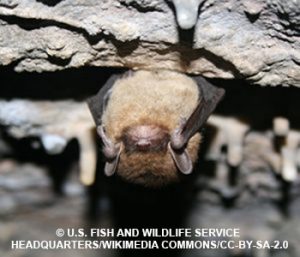Little Brown Bats
Biology
The Little Brown Bat is the one bat that people are the most familiar with. There are more of them in the United States and Canada than of other bat species combined. It is very small with it’s body size that is from 2.5 inches to 4 inches. They also weigh around a half an ounce. Their wing span is normally around 11 inches. They are brown in color and their ears are short and round. The Little Brown Bat is typically found living around swamp lands, although have been found living as far away as Alaska. There biggest recorded population is in New Hampshire. The female usually gives birth to one offspring each year. The little brown bat has a lifespan of six and a half years.
Feeding Preferences
The Little Brown Bat normally feeds on insects. Wasps and moths are the majority of their diet. They can eat up to half of their body weight every night.
Transmitted Diseases
A main concern is the diseases that can be spread by bats. The two major concerns are the lung disease histoplasmosis which can come from the bat guano, and the rabies virus, which comes from being bitten or scratched by an infected bat.
Facts On Rabies Being Transmitted By Bats:
One of the major concerns is that, bats can transmit rabies to humans. Though less than 1% of bats carry the rabies virus and transmit it, it is difficult to say if a colony of bats that is residing in the house has it or not. If a bat is weak, sick looking and found during the day there is a good likely hood it could be carrying rabies.
Habits
The Little brown bat sleeps and grooms during the day. They are fast creatures and hunt by night. They live in caves and mines during the winter months. Their hibernation can last from four to six months. The little brown bat will eat while they fly. If the little brown bat doesn’t find enough food, it will slow its heart rate while sleeping during the day. This allows it to save energy. The female Little Brown Bat is ready to mate from 7 to 9 months of age. Normally the males mature later around 1 year old. The young are born in either late June or early July. Typically only one young is born at a time. They grow very fast. They can’t fly at birth, so they hold onto the mother’s midsection and hang there. By the time they are a month old though they are already independent members of the colony.
BAT EXCLUSION AND CONTROL
Believe it or not but some bat species are protected. So where does this leave you as a homeowner? There are some laws to follow and Structural Pest is here to help.
Structural Pest will remove bats legally. Here is how the do it. The first thing that needs to happen is for an thorough inspection to be done. Our professionally trained technician will come to your house and look for all the holes the size of a golf ball or bigger where bats may enter. When an entry point is found then a one way door is installed so that the bat may get out but it cannot get back in again.
As a homeowner you will probably be concerned about the bat droppings and bat bugs that are left behind. We also offer a clean up service where we disinfect the bat droppings and rid you of any possible bat bugs for you with this service.
We provide a 3 year written warranty that covers all our work. It contains valuable information to help you from being a target for a bat residence. Call us today for a free phone estimate.
Structural Pest Bat Program
David will perform a thorough inspection on both the interior and exterior of your home, finding all the infested areas and identifying which pests you are dealing with. Once identified, David will implement a pest control program that is designed to target the specific pests in your home.

